The AMD A8-7670K APU Review: Aiming for Rocket League
by Ian Cutress on November 18, 2015 8:00 AM ESTGaming Benchmarks: Low End
To satisfy our curiosity regarding low-power gaming, as well as dual graphics arrangements, we ran our regular suite through each processor. On this page are our integrated graphics results, along with a cheaper graphics solution in the R7 240 DDR3 and, in the case of AMD, both of these together in dual graphics mode.
Alien: Isolation
If first-person survival mixed with horror is your sort of thing, then Alien: Isolation, based off of the Alien franchise, should be an interesting title. Developed by Creative Assembly and released in October 2014, Alien: Isolation has won numerous awards, ranging from Game Of The Year to several top 10s/25s and Best Horror titles, ratcheting up over a million sales by February 2015. Alien: Isolation uses a custom-built engine that includes dynamic sound effects and should be fully multicore enabled.
For low-end graphics, we test at 720p with Ultra settings, whereas for mid- and high-range graphics, we bump this up to 1080p, taking the average frame rate as our marker with a scripted version of the built-in benchmark.

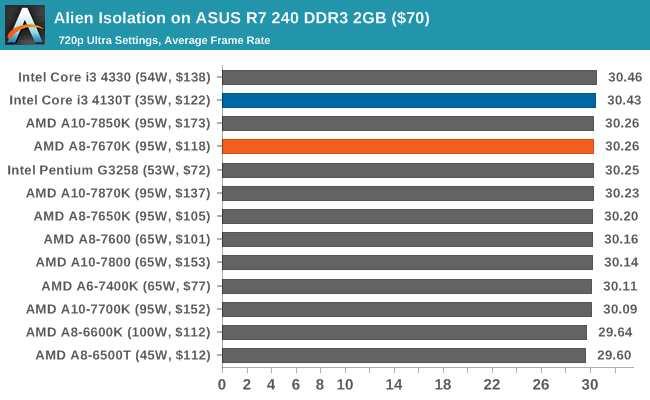
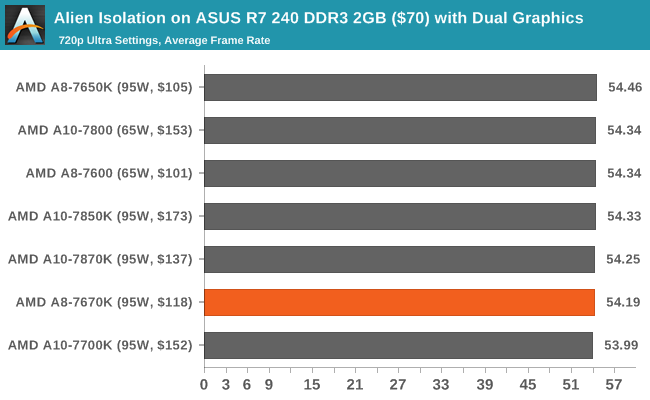
Total War: Attila
The Total War franchise moves on to Attila, another Creative Assembly development, and is a stand-alone strategy title set in 395AD where the main story line lets the gamer take control of the leader of the Huns in order to conquer parts of the world. Graphically, the game can render hundreds/thousands of units on-screen at once, all with their individual actions, and can put some of the big cards to task.
For low-end graphics, we test at 720p with performance settings, recording the average frame rate. With mid- and high-range graphics, we test at 1080p with the quality setting. In both circumstances, unlimited video memory is enabled, and the in-game scripted benchmark is used.
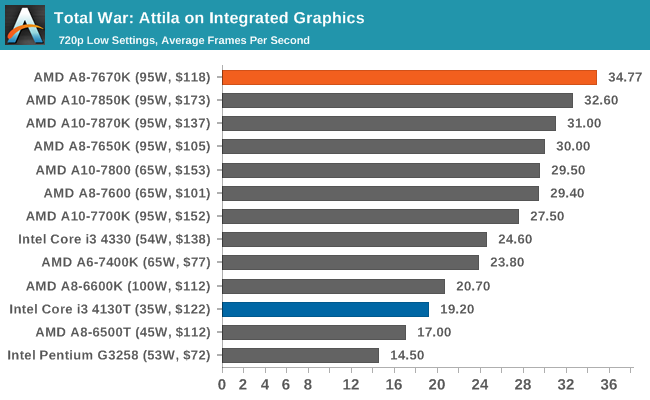

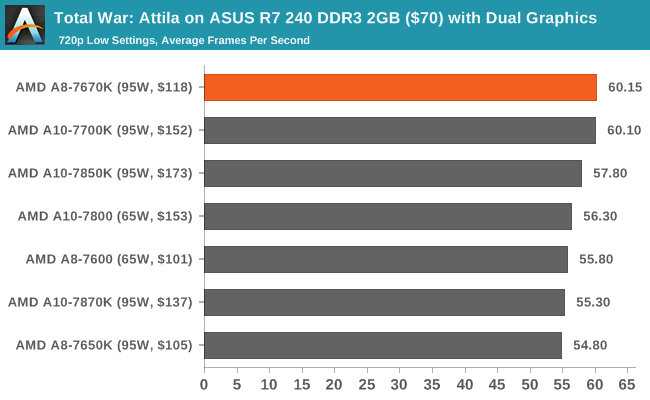
Grand Theft Auto V
The highly anticipated iteration of the Grand Theft Auto franchise finally hit the shelves on April 14, 2015, with both AMD and NVIDIA in tow to help optimize the title. GTA doesn’t provide graphical presets, but it opens up the options to users and extends the boundaries by pushing even the hardest systems to the limit using Rockstar’s Advanced Game Engine. Whether the user is flying high in the mountains with long draw distances or dealing with assorted trash in the city, when cranked up to maximum, it creates stunning visuals but hard work for both the CPU and the GPU.
For our test, we have scripted a version of the in-game benchmark, relying only on the final part, which combines a flight scene with an in-city drive-by, followed by a tanker explosion. For low-end systems, we test at 720p on the lowest settings, whereas mid- and high-end graphics play at 1080p with very high settings across the board. We record both the average frame rate and the percentage of frames under 60 fps (16.6 ms).

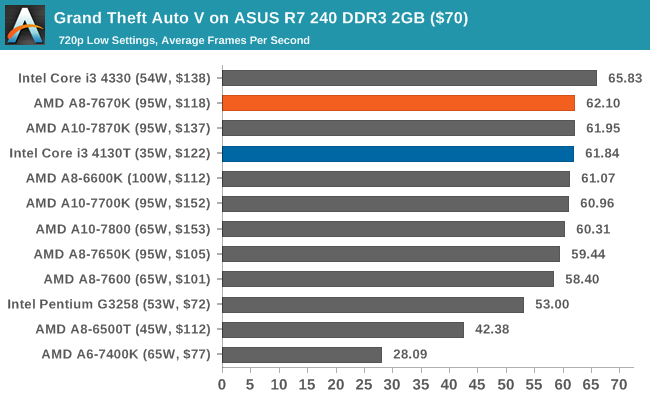
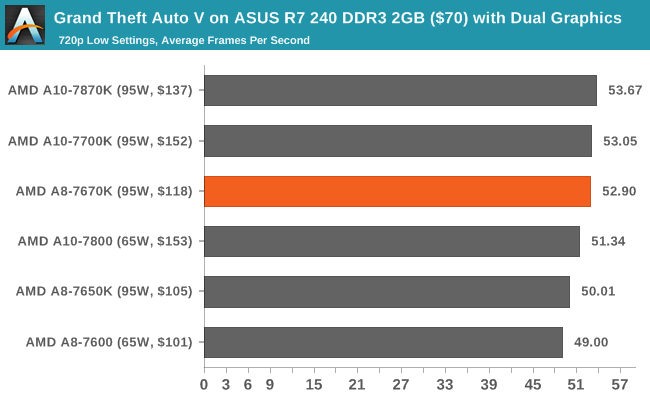
GRID: Autosport
No graphics test is complete without some input from Codemasters and the Ego engine, which means for this round of testing, we point toward GRID: Autosport, the next iteration in the GRID and racing genre. As with our previous racing testing, each update to the engine aims to add in effects, reflections, detail and realism, with Codemasters making "authenticity" a main focal point for this version.
GRID’s benchmark mode is very flexible, and as a result, we created a test race using a shortened version of the Red Bull Ring with 12 cars doing two laps. The player car is in focus throughout this benchmark and starts last, but usually finishes second or third. For low-end graphics, we test at 1080p and medium settings, whereas mid- and high-end graphics get the full 1080p maximum. Both the average and the minimum frame rates are recorded.
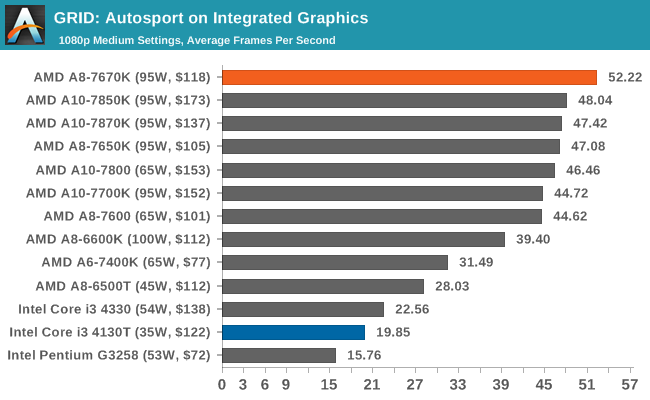
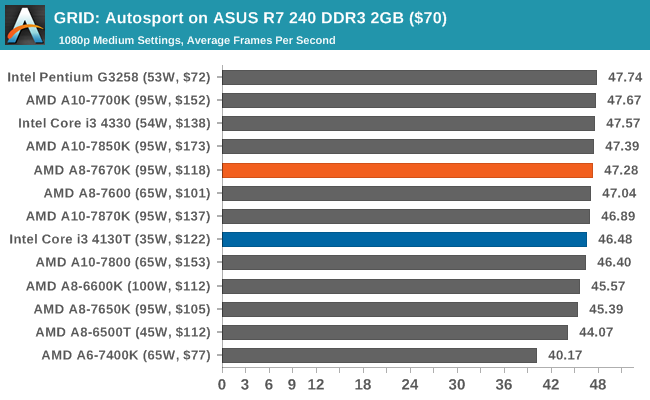
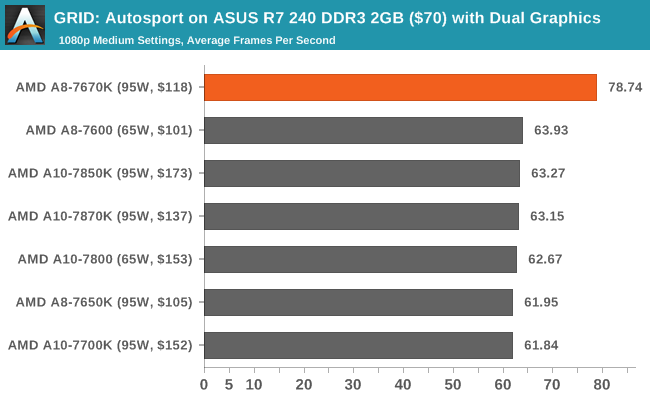
For whatever reason, the A8-7670K gets a good showing in the integrated tests, especially in dual graphics mode, with an abnormally high score. Some other issue might be at play here and warrants further testing.
Middle-Earth: Shadows of Mordor
The final title in our testing is another battle of system performance with the open-world action-adventure title Shadow of Mordor. Produced by Monolith using the LithTech Jupiter EX engine and numerous detail add-ons, SoM goes for detail and complexity to a large extent, despite having to be cut down from the original plans. The main story was written by the same writer as Red Dead Redemption, and it received Zero Punctuation’s Game of The Year in 2014.
For testing purposes, SoM gives a dynamic screen resolution setting, allowing us to render at high resolutions that are then scaled down to the monitor. As a result, we get several tests using the in-game benchmark. For low-end graphics, we examine at 720p with low settings, whereas mid- and high-end graphics get 1080p Ultra. The top graphics test is also redone at 3840x2160, also with Ultra settings, and we also test two cards at 4K where possible.
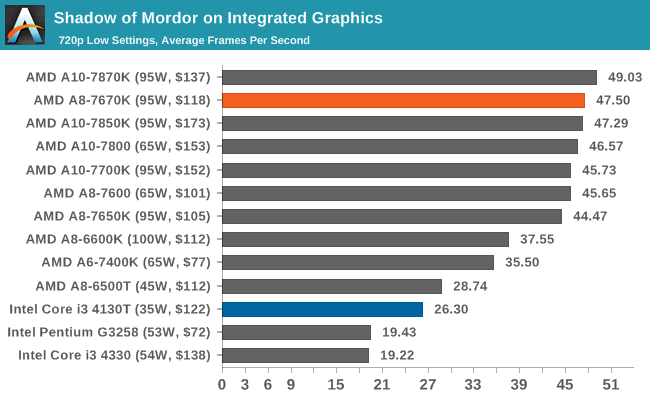
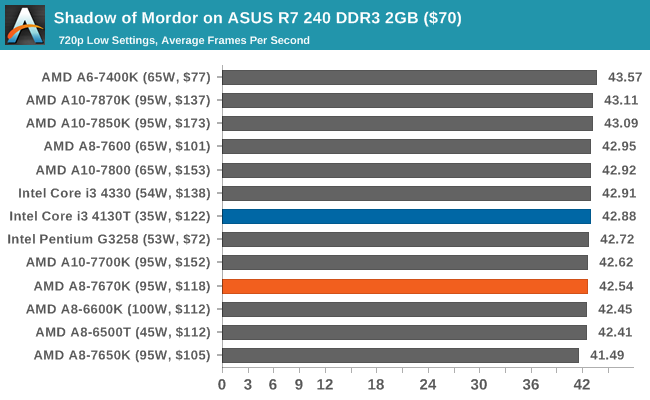
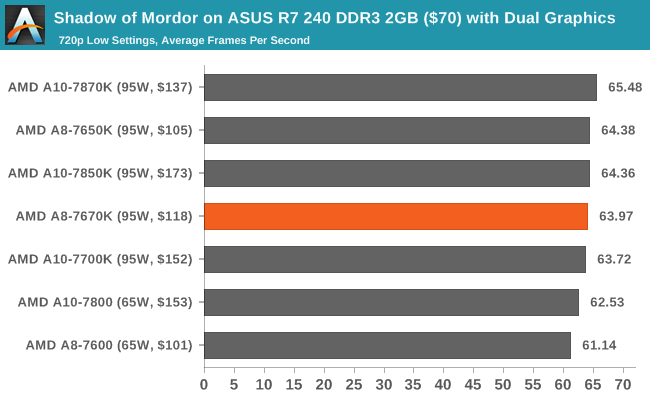















154 Comments
View All Comments
milli - Thursday, November 19, 2015 - link
Sounds good :)BrokenCrayons - Thursday, November 19, 2015 - link
95 watts is too much for a modern CPU to require.plonk420 - Thursday, November 19, 2015 - link
that's watts TDP, not watts at the wall.BrokenCrayons - Friday, November 20, 2015 - link
Yes, that's fine. It's too high for a modern CPU. Half that would be more reasonable and a tenth would be better still, but not at all perfect.TheinsanegamerN - Friday, November 20, 2015 - link
The i3 is still a 47 watt chip. the skylake i7s are 95 watt. It seems most "modern" cpus are in the 65-95 watt range, with 47 watt for dual cores.A tenth of 95 watt is only 9.5, which is core m territory. it works, but it ISNT for power users. So i'm not sure what 'modern' cpu you are referring to, as it doesn't seem to exist. And AMD's APUs can be set to 65 or 45 watt mode as well, but you get a performance hit. So half the TDP already exists, and a tenth is too little for a big CPU.
BrokenCrayons - Friday, November 20, 2015 - link
Yes, the i3 is an Intel processor. Skylake's 95 watt chip is an outlier that's highly uncommon. The vast majority of computers purchased are inexpensive laptops which regularly only rise to 35 watts. Desktop processors are not only a rarity, but those that range above 65 watts are very uncommon and largely the domain of expensive workstations and the very small number of gaming systems out there. It's pretty odd of AMD to sell a budget processor that puts those kinds of demands on a system and, in my opinion, unreasonable given the competition in the same approximate performance.silverblue - Friday, November 20, 2015 - link
I know it's hardly comparable, but I wonder what power an i3 with Godavari-level GPU would use if at 28nm. Besides, TDP != actual power usage.TheinsanegamerN - Friday, November 20, 2015 - link
Desktops are rare now? Ok. You must not work in business. Desktops Are still common, not as much as laptops, but the forecast for all of 2015 was north of 120 million desktops, the vast majority of which are business machines with i5 processors, which are 65-84 watt. I7s are rated at 84 watt for haswell, 77 for ivy bridge, and 95 for sandy bridge, and 95 for skylake, so it's much more common than you think.As for laptops, I'm not sure why you brought them up, seeing as the a8 is a DESKTOP chip. on DESKTOPs, CPUs with 65 watt TDPs are very common. Any i5, i7, pretty much any APU from AMD, are all 65 watt+. Laptops typically use dual core chips with much lower clock rates and power restricted GPUs. The vast majority of laptops, with those 35 watt chips (and most of the skylake and broadwell chips in laptops are 15 watt BTW, 35 watt isn't really used much anymore) can't compare to a 95 watt desktop chip in performance, so it still won't work for power users.
So when you say that the TDP is too high for a modern processor, you mean it's too much for a mobile processor, ignoring that this is a processor for desktops. Unless you want a desktop processor with a mobile TDP but desktop performance, which will never happen, because a higher TDP chip will be clocked higher. Always.
Deshi - Friday, November 20, 2015 - link
Does that 95 watts include the onboard GPU? if thats the case, thats not so bad, since you would need to addin the added dGPU TDP if you build an intel + nvidia/radeon to match the performance.nos024 - Thursday, November 19, 2015 - link
blah...after 4 years and Intel's IGP is still on the heels of AMD's APU. Bleh.Give me graphics performance comparable to a 750ti and an ITX motherboard with M.2 storage option and I'll will go and buy it this very instance. I want something like that.
Low profile ITX-case + 8gb RA
M + 240/256GB M.2 RAM (SATA or PCIe) + 300W PSU + ITX MB with AC wireless + APU with 750ti GPU performance. Is that so hard to ask for?! Apparantly so.